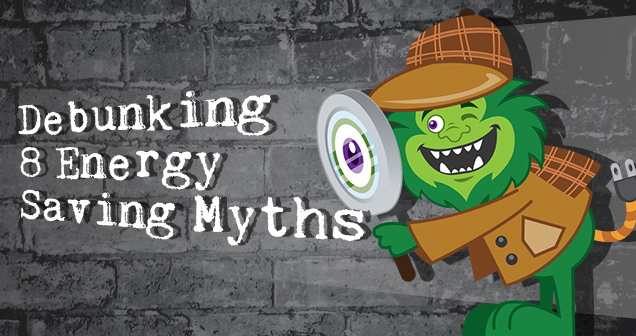Are you searching for ways to increase the energy efficiency of your home? Is bad advice from your friends leaving you wondering where all the savings are? Team up with Wattson, our sleuthing mascot, as he solves the top 8 energy mysteries and uncovers real ways to save.
1. Houses need to breathe so don’t over-insulate.
Getting fresh air into the home may be necessary, but it should be done using controlled or mechanical air vents that are filtered. Air that enters the home through cracks, gaps and other leaks is not only unheated, but it can be full of dust, allergens, and moisture. To truly increase the energy efficiency of your home’s heating and cooling systems, seal up as tightly as possible.
2. Electric space heaters contain heat to where it is needed and therefore increase energy efficiency.
Electric space heaters use a lot of electricity and electricity can cost as much as two times what natural gas does. You may actually be spending more to heat a small area with a space heater than you would to heat the entire home. Plus, space heaters account for more than 20,000 fires and 300 deaths each year.
3. Closing vents in unused rooms is a good way to increase energy efficiency.
This seems like an obvious way to help the furnace run less, however, a furnace will produce enough heated air to fill the entire duct system no matter how many vents are open. Closing vents will redirect heat to other rooms, but it will also change the pressure in the system and may cause the furnace to work even harder.
4. Wood stoves are more work than the little bit of energy they might save.
This may have been true in the past, however, technology has caught up with wood burning stoves and today’s models burn wood very efficiently and completely. This means they’ll produce more heat as you spend less time filling them up and cleaning them out.
5. Insulating the ceiling will cause air to leak out through walls and other openings so there’s no real benefit.
The pressure in your home would have to be dramatically increased in order for increased insulation to force air out of other openings. Never hesitate to add insulation to the ceiling or anywhere else in the home – the more the better!
6. Setting the thermostat higher will heat up cold rooms faster.
Your furnace produces a fixed amount of heat no matter what the thermostat is set to, there is no way to increase the temperature of the air it produces. Instead, keep rooms warm to avoid having to heat them up quickly.
7. Putting computers to sleep or in hibernation mode overnight is good enough.
Sleep modes and hibernation modes only use a fraction less energy than a computer that is up and running. In order to truly save energy, your computer should be shut down and monitors should be turned off. Even better, plug them all into a power strip and flip the switch on the strip after shutting everything down.
8. Screen savers are a good way to use less energy from your computer.
Not only are screen savers a great way to download viruses to your computer, some of them use more computer power to run than surfing the internet or using common programs. They may be fun to use, but they do not save any energy.








